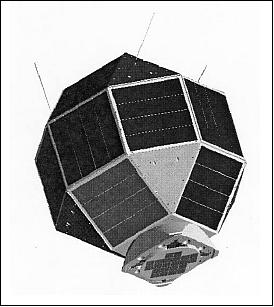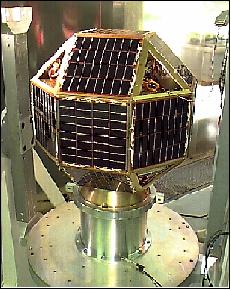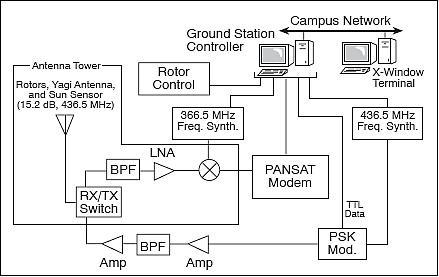PANSAT (Petite Amateur Navy Satellite)
Non-EO
Education
Technology and Research
Quick facts
Overview
| Mission type | Non-EO |
| Launch date | 29 Oct 1998 |
PANSAT (Petite Amateur Navy Satellite)
PANSAT was designed and built and operated at the Naval Postgraduate School (NPS) in Monterey, CA, USA as an educational project for officer students. It is a low-cost microsatellite for messaging or relay services. The overall objective is to demonstrate digital communications using direct-sequence spread-spectrum and store-and-forward packet radio technology. 1) 2) 3) 4) 5) 6) 7)

Spacecraft
The satellite is about 50 cm in diameter (roughly a spherical configuration). Eighteen square and eight triangular aluminum panels make up the outer surface of the satellite. Seventeen of the square panels are equipped with silicon solar panels and one gallium-arsenide panel is attached at the bottom of the launch vehicle interface (LVI). Four dipole antennas are attached in a tangential turnstile configuration to the triangular plates. The spacecraft interior structure is composed of two equipment plates and a cylindrical support.
The S/C subsystems consist of the following elements:
• DCS (Digital Control Subsystem, use of Intel M80C186XL operating at 5 MHz)
• TMUX (Telemetry Multiplexer)
• RF modem
• Rx/Tx (Receiver/Transmitter)
• EPS (Electrical Power Subsystem): The EPS consists of solar cells for primary power, nickel-cadmium batteries for eclipse power, and power regulation/conditioning circuitry. The EPS relies on the main spacecraft processor for activating relays and for determining charge levels and charge cycles. Power is provided through an unregulated 12 V ±3 V bus and regulated at each subsystem module. A shunt regulator is not being implemented in the design since the solar array voltage will never exceed the maximum input voltage of any subsystem DC-DC converter.

The primary functions of the DCS (Digital Control Subsystem) are to provide control of the EPS, control and operation of the COMM payload, gather and store telemetry data, and perform memory management and control for message handling. The DCS consists of fully redundant control boards, each run by a M80C186XL microprocessor.
The M80C186XL microprocessor has been selected for several reasons. This microprocessor consumes low power, has tolerance to radiation, and integrates many common digital peripherals which reduces the design complexity. Also, the M80C186XL will provide a software environment that is object code compatible with PCs which are used for PANSAT software development. Most importantly, the M80C186XL supports a special preemptive multi-tasking operating system, the SCOS (Space Craft Operating System), and a companion product which implements the AX.25 protocol, BAX (BekTek AX.25).

The S/C design is kept very simple. There is neither an attitude control system nor an on-orbit propulsion system. This makes PANSAT a tumbling S/C. The microsatellite has a total mass of 57 kg, power = 17 W. The design life is 2 years.


Launch
PANSAT was launched as a Hitchhiker (HH) payload on Shuttle flight STS-95 (Oct. 29, 1998) form Cape Canaveral, FL. The AMSAT community named PANSAT Oscar-34.
Orbit: LEO near-circular orbit, altitude = 554 km, inclination = 28.45º, period = 95.6 minutes.
Mission Status
• PANSAT was designed for a two-year mission life. The S/C completed its fourth operational year at the end of Oct. 2002. Contact with the satellite was lost in 2003.
• PANSAT was deployed on Oct. 30, 1998 as a non-recoverable spacecraft. Use of the HES Hitchhiker Ejection System from the payload bay. HES imparted a spin about the satellites main axis of about 1 rpm.
Communications Payload
The COMM payload consists of two direct sequence spread spectrum transmitters and receivers. Each unit is capable of switching from spread spectrum modulation to narrow-band binary-phase-shift keying (BPSK) transmission/reception. This allows for contingency operation as well as providing the capability of down-linking a narrow band telemetry beacon. The latter is of interest to those users lacking the capability of spread spectrum, or those in the early stage of setting up their ground station equipment. The COMM payload is designed using commercial off the shelf (COTS) components. Radiation-hardened components are used only in critical subsystem areas.
The antenna design employs four quarter-wave length beryllium copper elements mounted at the top four corners of the S/C.
A UHF operating center frequency of 436.5 MHz is used, a bit rate of 9600 bit/s and 4 MByte of message storage. The AX.25 protocol is being used for downlink data transmission. Amateur radio ground stations are able to utilize PANSAT for store-and-forward communication and to test digital direct sequence spread-spectrum communication techniques. In addition, PANSAT provides many potential applications for low-cost communications. The low probability-of-intercept is an important feature for the military in downed-pilot-rescues. The pilot could obtain his/her location through a GPS system and uplink the information to the orbiting satellite at low risk. 8)
Examples of civilian uses include emergency rescue and communication to remote areas. A modified amateur satellite ground station is needed to communicate with PANSAT. The NPS ground station utilizes off-the-shelf software, is microcomputer controlled, and is equipped with a spread-spectrum modem.
Ground Operations
The NPS ground station is similar to a typical amateur radio user station, except it has spacecraft command capability. The NPS ground station is also utilized as a classroom instructional laboratory.
The basic configuration includes a PC with application software to perform a bulletin-board-like interface, the TNC (Terminal Node Controller) which maintains the link management (implementing the AX.25 protocol), the transmitter, receiver, and antenna system. The antenna system includes azimuth and elevation rotors for ground tracking. Ground tracking is done by using the predicted spacecraft ephemeris and is, therefore, open-loop. The ground station is also required to perform Doppler compensation for both up-link and down-link transmissions.

References
1) Ronald L. Phelps, “Operational Experiences with the Petite Amateur Navy Satellite - PANSAT,” AIAA/USU Conference on Small Satellites, Aug. 13-16, 2001, SSC-01-V-7
2) Daniel Sakoda, “The Petite Amateur Navy Satellite (PANSAT) Hitchhiker Ejectable,” 1999 Shuttle Small Payloads Project Office Symposium, Sept. 1999, URL(presentation): http://library01.gsfc.nasa.gov/host/hitchhiker/pansat.ppt
3) Daniel Sakoda, “The Petite Amateur Navy Satellite (PANSAT) Hitchhiker Ejectable,” 1999 Shuttle Small Payloads Project Office Symposium, Sept. 1999, URL (paper): http://sp.nps.edu/papers/SSPS99A.pdf
4) J. A. Horning, “Navy Education through Amateur Radio Satellite Development,” AIAA Space Programs and Technologies Conference and Exhibit, September 21-23, 1993, Huntsville, AL, USA, AIAA 93-4211, URL: http://sp.nps.edu/papers/aiaa4211.pdf
5) Steven R. Bible, Dan Sakoda, “Petite Amateur Navy Satellite,” URL: http://sp.nps.edu/papers/ovw_0895.pdf
6) Jim A. Horning, “PANSAT Functional Testing Software and Support Hardware,” 1999 Shuttle Small Payloads Project Office Symposium, Sept. 1999, URL (paper): http://sp.nps.edu/papers/SSPS99B.pdf
7) Daniel Sakoda, “Overview of the Naval Postgraduate School Petite Amateur Navy Satellite (PANSAT),” 13th AIAA/USU Conference on Small Satellites, Logan, Utah, USA, Aug. 23-26, 1999., SSC99-I-5, URL: http://sp.nps.edu/papers/SSC99I5.pdf
8) G. Ken Hunter, Neil C. Rowe, “Software Design For a Fault-Tolerant Communications Satellite,” URL: http://www.dodccrp.org/events/2000_CCRTS/html/pdf_papers/Track_2/011.pdf
The information compiled and edited in this article was provided by Herbert J. Kramer from his documentation of: ”Observation of the Earth and Its Environment: Survey of Missions and Sensors” (Springer Verlag) as well as many other sources after the publication of the 4th edition in 2002. - Comments and corrections to this article are always welcome for further updates (eoportal@symbios.space).